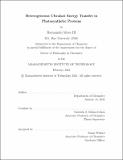Heterogeneous Ultrafast Energy Transfer in Photosynthetic Proteins
Author(s)
Moya III, Raymundo
DownloadThesis PDF (19.91Mb)
Advisor
Schlau-Cohen, Gabriela S.
Terms of use
Metadata
Show full item recordAbstract
Photosynthesis begins with the absorption and rapid transport of energy through a protein network to reach the reaction center, where conversion to chemical energy occurs. The energy transport is facilitated through a series of energy transfer events between pigments bound to a protein backbone. These steps exhibit a remarkable near-unity quantum efficiency. Energy transfer rates are exquisitely sensitive to intermolecular distances, which vary within proteins due to thermal fluctuations of the structure. As a result, models predict that the energy transfer rates vary dramatically between proteins, producing some instances of inefficient energy transfer. Reconciling the high efficiency with the presence of thermal fluctuations has not been possible, because whether energy transfer rates in photosynthetic proteins actually vary and, if so, by how much has not been measured.
Previous experiments to measure rates relied on ensemble ultrafast spectroscopy, which is limited to average values. With single-molecule approaches, we can overcome the limitations of ensemble averaging by measuring individual proteins. However, single-molecule experiments have been primarily restricted to fluorescence, which occurs on a nanosecond timescale. The limited knowledge provided by ensemble averaging or nanosecond dynamics cannot describe heterogeneity in femtosecond energy transfer rates. Therefore, direct measurements of the distribution are required.
In this thesis, we expand upon a novel technique, single-molecule pump-probe spectroscopy (SM2P), which measures energy transfer rates at the single-molecule level. In Chapter 2, I describe a newly developed SM2P apparatus that is easily tunable across the visible region and demonstrate its utility on a fluorescent dye. In Chapter 3, I expand upon these results by applying SM2P to photosynthetic light- harvesting systems, where we are able to directly measure the distribution of energy transfer rates on cyanobacterial light-harvesting subunits. These novel experiments provide insight into how photosynthetic light-harvesting proteins are robust to thermal fluctuations and tightly regulate energy transfer rates. Lastly, in Chapter 4 I present the first single-molecule experiments on light-harvesting complexes from cryptophyte algae. The results imply that light-harvesting complexes from cryptophytes maintain the ability to regulate light harvesting through quenched states that prevent excess sunlight from damaging the light-harvesting machinery.
Date issued
2022-02Department
Massachusetts Institute of Technology. Department of ChemistryPublisher
Massachusetts Institute of Technology